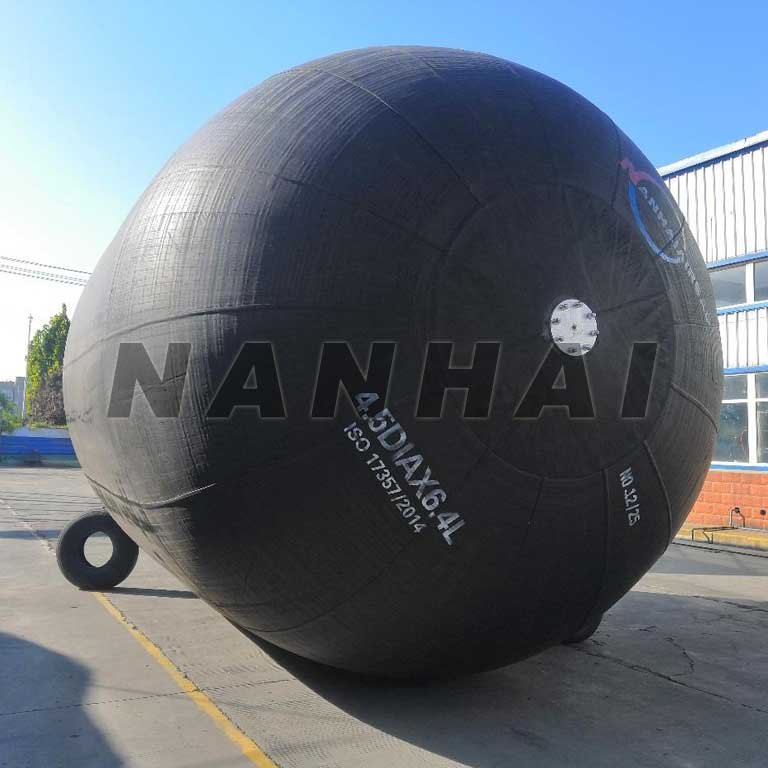المصدات الخلوية في الإمارات العربية المتحدة
08/21/2025مصدات يوكوهاما في إندونيسيا: حماية موثوقة للسفن
08/22/2025المصدات الهوائية الهوائية في عرض البحر CTN مقابل الرافعة التي تعمل بشكل أفضل
عندما يتعلق الأمر ب العمليات البحرية، اختيار المناسب المصدات الهوائية أمر بالغ الأهمية للسلامة والكفاءة وحماية كل من السفن والمنشآت البحرية. سواء كنت تتعامل مع STS (عمليات النقل من سفينة إلى سفينة), عمليات FPSOأو الإرساء طويل الأجل، فإن اختيار النوع الصحيح يمكن أن يحدث فرقاً كبيراً.
في السوق، يهيمن نوعان رئيسيان - CTN (سلسلة-إطارات-شبكة-إطارات-شبكة) و نوع الحمالة مصدات مطاطية تعمل بالهواء المضغوط. ولكن أيهما يعمل بشكل أفضل في الخارج؟ دعنا نحلل الأمر.
ما هي المصدات الهوائية المقطعية والمصدات الهوائية الرافعة؟
الحاجز الهوائي CTN:
مصممة بغطاء واقي شبكة سلسلة الإطارات المتسلسلة توفر موديلات CTN حول جسم الرفراف متانة فائقة ومقاومة للتآكل. إنها الخيار المفضل لـ العمليات البحرية للخدمة الشاقةحيث تتعرض المصدات في كثير من الأحيان لظروف قاسية وسيناريوهات الاحتكاك العنيف، مثل ناقلات النفط, ناقلات الغاز الطبيعي المسالو تحويلات STS.
مصدات هوائية من نوع الرافعة:
لا تحتوي هذه الرفارف على غطاء خارجي للإطار والسلسلة. إنها أخف وزناً, أسهل في التثبيتوأقل عرضة لترك علامات على أسطح بدن السفينة. تُستخدم أنواع الرافعة بشكل شائع في السفن الأصغر حجماً, الرسو المؤقتأو تشطيبات بدن حساسة مثل تلك الموجودة على سفن الرحلات البحرية أو السفن البحرية.


الظروف البحرية والمتطلبات الفنية للمصدات الهوائية في عرض البحر
البيئات البحرية أكثر تطلباً بكثير من الموانئ أو المرافئ المحمية. اختيار الميناء المناسب درابزين هوائي يتطلب فهم كل من التحديات و سيناريوهات استخدام محددة:
سيناريوهات الاستخدام البحري النموذجي
- ناقلات الغاز الطبيعي المسال والمحطات الطرفية → المصدات الهوائية توفير امتصاص الطاقة العالية اللازمة لحماية كل من السفن والأرصفة أثناء عمليات التحميل والتفريغ.
- وحدات الإنتاج والتخزين والتفريغ العائمة (FPSOs) → تُستخدم لحماية كل من وحدات الإنتاج والتخزين والتفريغ والإمداد أثناء الإرساء جنبًا إلى جنب في البحار المفتوحة.
- ناقلات النفط وناقلات النفط العملاقة → تعتبر المصدات المطاطية الهوائية الهوائية CTN شديدة التحمل ضرورية للرسو الآمن ونقل البضائع في نظام النقل الآمن.
- عمليات STS (من سفينة إلى سفينة) ← تُستخدم المصدات المطاطية الهوائية على نطاق واسع لامتصاص طاقة الصدمات عند نقل النفط الخام أو الغاز الطبيعي المسال أو المنتجات المكررة بين سفينتين.
- المنصات البحرية وسفن الإمداد ← يحمي كلاً من أرجل المنصة وسفن الإمداد أثناء الرسو المتكرر في ظروف البحر الهائجة.
التحديات التقنية الرئيسية في الخارج
- أمواج عالية وتيارات قوية → تتحرك السفن بشكل غير متوقع، مما يزيد من خطر الاصطدام.
- تأثيرات الطاقة الثقيلة ← ناقلات النفط الكبيرة وناقلات الغاز الطبيعي المُسال وسفن الإمداد غالبًا ما تتطلب مصدات ذات قدرة امتصاص طاقة عالية جدًا.
- التعرض طويل الأمد → تتطلب الأشعة فوق البنفسجية والمياه المالحة والطقس القاسي متانة معززة وميزات مقاومة للتآكل.
- ظروف النشر المعقدة → غالباً ما يحدث الإرساء في البحر في مساحات ضيقة مع وجود مساحة ضئيلة للخطأ.
بسبب هذه العوامل, المصدات الهوائية CTN غالباً ما تكون مفضلة في الخارج بسبب متانتها وحمايتها الإضافية.
لماذا يوصى باستخدام المصدات الهوائية CTN في عرض البحر
- متانة فائقة
الخارجية شبكة سلسلة الإطارات المتسلسلة يعمل كدرع يحمي جسم الحاجز من التآكل والصدمات الحادة - وهو أمر ضروري في العمليات البحرية. - امتصاص أفضل للطاقة
يمكن لمصدات CTN التعامل مع طاقة عالية التأثير من السفن الضخمة مثل ناقلات النفط الخفيفة ذات العيار الثقيل و ناقلات الغاز الطبيعي المسال أثناء عمليات STS. - عمر خدمة أطول
البيئات البحرية قاسية، ولكن مصدات CTN تتحمل التعرض المستمر بشكل أفضل، مما يقلل من تكاليف الاستبدال والصيانة على المدى الطويل. - مثالية للاستخدامات الشاقة
بالنسبة لـ وحدات إنتاج النفط والغاز والبترول والبتروكيماويات, محطات الغاز الطبيعي المسالأو عمليات نقل ناقلات النفط STSتوفر المصدات الهوائية من CTN موثوقية وأداءً لا يمكن لأنواع الرافعات أن تضاهيها.
عندما تكون المصدات الهوائية من نوع الرافعة منطقية
على الرغم من تفضيل استخدام الرافعة الهوائية من نوع الرافعة CTN في عرض البحر، إلا أن الرفراف الهوائية من نوع الرافعة لا تزال لها مزايا في بعض الحالات:
- النشر السريع → خفيف الوزن وسهل التعامل معه.
- العمليات البحرية المؤقتة → مثالية للحماية قصيرة الأجل عندما لا تكون هناك حاجة إلى عمر خدمة طويل.
- السفن الحساسة للبدن → مثالي لسفن الرحلات البحرية واليخوت والسفن البحرية حيث يكون عدم ترك أي علامات أمرًا بالغ الأهمية.
كيفية اختيار المصدات الهوائية البحرية المناسبة
عند تحديد مصدات مطاطية تعمل بالهواء المضغوط للاستخدام البحري، ضع في اعتبارك ما يلي:
- الحجم والأبعاد → القطر × الطول بناءً على فئة الوعاء.
- الضغط الأولي المقدر → 50 كيلو باسكال مقابل 80 كيلو باسكال، حسب متطلبات طاقة الصدم.
- امتصاص الطاقة وقوة رد الفعل ← طابق احتياجاتك التشغيلية.
- جودة المواد → مواصفات السلسلة والإطارات والجسم المطاطي.
- الامتثال → ضمان المواصفة القياسية ISO 17357-1 شهادة السلامة البحرية.
- احتياجات الصيانة → عامل فترات الاستبدال وتوفر قطع الغيار.
الأسئلة الشائعة
1. هل تتطلب العمليات البحرية دائماً مصدات هوائية من نوع CTN؟
ليس دائمًا، ولكن يوصى بشدة باستخدام مصدات CTN من أجل العمليات البحرية شديدة التحمل وعالية الطاقة في الخارج مثل عمليات النقل عبر السفن العابرة للقارات (STS) ورسو الغاز الطبيعي المسال.
2. هل يمكن استخدام المصدات الهوائية من نوع الرافعات الهوائية في عرض البحر؟
نعم، ولكن فقط من أجل الخدمة الخفيفة أو قصير الأجل العمليات. فهي أقل ملاءمة للسفن الكبيرة أو ظروف البحر الهائجة.
3. لماذا تُعتبر ناقلات الغاز الطبيعي المسال وناقلات الغاز الطبيعي المسال ووحدات الإنتاج والتفريغ والتفريغ المملوكة للدولة أفضل من ناقلات الغاز الطبيعي المسال؟
تتطلب هذه السفن أقصى امتصاص للطاقة و المتانة بسبب حجمها وطبيعة عمليات نقل البضائع البحرية عالية المخاطر.
4. أيهما أكثر فعالية من حيث التكلفة في الخارج - الشبكة المقطعية أم الرافعة؟
تتميز CTN بتكلفة مقدمة أعلى، ولكنها تدوم لفترة أطول وتوفر حماية أفضل، مما يقلل من المخاطر التشغيلية طويلة الأجل و تكاليف الاستبدال.
خاتمة
بالنسبة لـ البيئات البحريةخاصة تلك التي تتضمن ناقلات الغاز الطبيعي المسال, وحدات إنتاج النفط والغاز والبترول والبتروكيماويات, ناقلات النفطو تحويلات STS, سي تي إن مصدات مطاطية تعمل بالهواء المضغوط هي الخيار الأكثر أماناً وموثوقية. إن متانتها الفائقة وامتصاصها للطاقة وحمايتها تجعلها معيار الصناعة للتطبيقات البحرية الصعبة.
ومع ذلك، إذا كانت عمليتك تتضمن السفن الأصغر حجماً, الإرساء قصير الأجلأو السفن الحساسة للبدن, درابزين مطاطي هوائي من نوع الرافعة توفر بديلاً أخف وزناً وأكثر مرونة.
